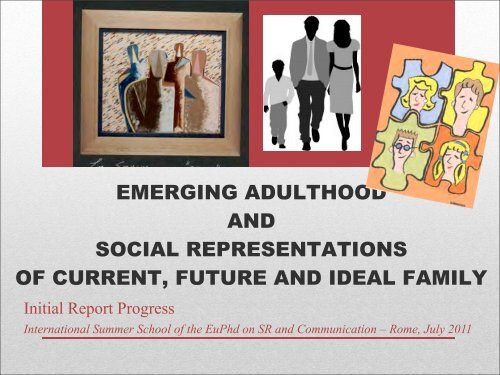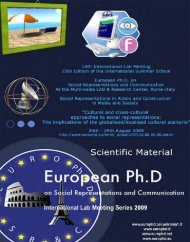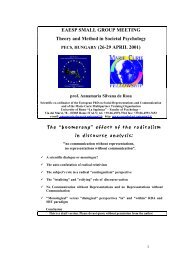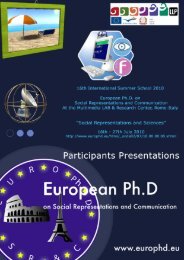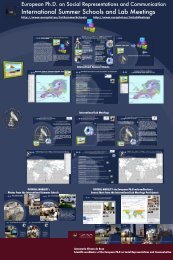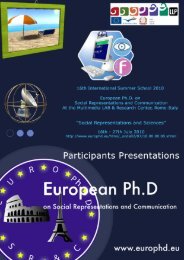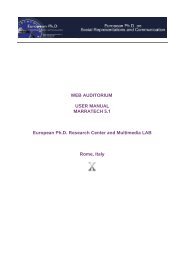Emerging adulthood and SRs of current, future and ideal family
Emerging adulthood and SRs of current, future and ideal family
Emerging adulthood and SRs of current, future and ideal family
Create successful ePaper yourself
Turn your PDF publications into a flip-book with our unique Google optimized e-Paper software.
EMERGING ADULTHOOD<br />
AND<br />
SOCIAL REPRESENTATIONS<br />
OF CURRENT, FUTURE AND IDEAL FAMILY<br />
Initial Report Progress<br />
International Summer School <strong>of</strong> the EuPhd on SR <strong>and</strong> Communication – Rome, July 2011
The definition <strong>of</strong> <strong>family</strong> depends on<br />
the point <strong>of</strong> view you assume, on the<br />
theoretical frame you choose to<br />
lead <strong>and</strong> guide your research.<br />
THEORETICAL MODELING<br />
(Scabini, 2002)
THEORETICAL MODELING<br />
FAMILY<br />
AS<br />
SCIENTIFIC<br />
KNOWLEDGE
THE SYMBOLIC-RELATIONAL MODEL<br />
(Scabini & Cigoli 2000)<br />
Family is a unique <strong>and</strong> specific SOCIAL ORGANIZATION<br />
that CONNECTS <strong>and</strong> TIES the crucial differential variables:<br />
* different GENDERS (male <strong>and</strong> female),<br />
* different GENERATIONS (parents <strong>and</strong> children),<br />
* different LINEAGES (origins <strong>of</strong> the father <strong>and</strong> origins <strong>of</strong> the mother).<br />
GENERATIVITY as main goal <strong>and</strong> intrinsic function <strong>of</strong> the <strong>family</strong><br />
(Erikson, 1959).<br />
THEORETICAL MODELING
THEORETICAL MODELING<br />
FAMILY<br />
AS<br />
SOCIAL<br />
REPRESENTATION
THINKING FAMILY AS A SOCIAL<br />
REPRESENTATION<br />
“Family, as social institutions, can be considered as<br />
Social Representation (SR):<br />
it has a collective <strong>and</strong> a normative dimension<br />
coming from iconography <strong>and</strong> culture<br />
<strong>and</strong> a more personal dimension,<br />
due to the relations that every person experiences<br />
in its own <strong>family</strong>” (D’Atena, 1996).<br />
THEORETICAL MODELING
INTEGRATING SYMBOLIC-RELATIONAL MODEL<br />
TO THE SOCIAL REPRESENTATION THEORY<br />
FAMILY<br />
AND<br />
ITS MEMBERS<br />
SOCIAL<br />
OBJECT<br />
(GENDERS,<br />
GENERATIONS,<br />
LINEAGE AMONG<br />
OTHERS)<br />
CULTURE CULTURE<br />
FAMILY SHARED<br />
<strong>SRs</strong><br />
Dynamic between Normative<br />
Dominant HEGEMONIC <strong>and</strong><br />
Minorities’ or less consensual <strong>SRs</strong><br />
CULTURE<br />
GROUP SHARED<br />
<strong>SRs</strong><br />
ALTER<br />
(SIMILAR<br />
OR<br />
DIFFERENT)<br />
Dynamic between Normative<br />
Dominant HEGEMONIC <strong>and</strong><br />
Minorities’ or less consensual <strong>SRs</strong>
THEORETICAL MODELING<br />
FAMILY<br />
AS<br />
COMMON SENSE
FROM TRADITIONS TO PERSONAL RULES<br />
The thinking society <strong>and</strong> norms - From dominant values system to<br />
institutional norms:<br />
Art.29 <strong>of</strong> Italian Constitution: Italy recognizes <strong>family</strong> as social institution <strong>and</strong><br />
identifies its rights when it is based on marriage<br />
The “subjectivations <strong>of</strong> norms” (Bozon, 2004), operating in effect in the<br />
direction <strong>of</strong> a de-institutionalization <strong>of</strong> the traditional forms <strong>of</strong> the<br />
<strong>family</strong>, constitutes a process that goes back to the dimension <strong>of</strong><br />
individualization <strong>and</strong> that has a deep impact on <strong>family</strong> life.<br />
• Beside every personalization <strong>of</strong> models <strong>and</strong> process, the social nature <strong>of</strong><br />
<strong>family</strong> <strong>and</strong> its social role in generation <strong>and</strong> mediation <strong>of</strong> sense,<br />
representations <strong>and</strong> expectations for gender, generation <strong>and</strong> culture<br />
doesn’t allow the disappearing <strong>of</strong> the <strong>family</strong> itself.<br />
ITALIAN BACKGROUND
SAMPLE<br />
IDENTIFICATION<br />
RESEARCH PLANNING AND METHODOLOGICAL DESIGN
SAMPLE IDENTIFICATION<br />
100 EMERGING ADULTS<br />
RESEARCH PLANNING AND METHODOLOGICAL DESIGN
EMERGING ADULTHOOD (Arnett, 2000)<br />
<strong>Emerging</strong> <strong>adulthood</strong> is proposed as a new conception <strong>of</strong><br />
development, a distinct period demographically, neither adolescence<br />
nor young <strong>adulthood</strong>, subjectively, <strong>and</strong> in terms <strong>of</strong> identity<br />
explorations with a focus on age 18-25*.<br />
It exists only in that culture, such as post industrial, allowing young<br />
people a prolonged period <strong>of</strong> independent role exploration<br />
during the late teens <strong>and</strong> twenties.<br />
(Arnett, 2000)<br />
<strong>Emerging</strong> <strong>adulthood</strong> is the only period <strong>of</strong> life in which<br />
nothing is normative demographically (Rindfuss, 1991; Wallace, 1995).<br />
RESEARCH PLANNING AND METHODOLOGICAL DESIGN
EMERGING ADULTHOOD<br />
IMPORTANT MARKERS OF THE CONCEPTION OF THE<br />
TRANSITION TO ADULTHOOD (ARNETT, 1997).<br />
The top three criteria emphasize individualistic qualities such as:<br />
•Independence “decide on personal beliefs <strong>and</strong> values independently <strong>of</strong><br />
parents or other influence”;<br />
•Equality "accepting responsibility for one's self”.<br />
Other criteria endorsed by a majority in studies also emphasized<br />
individualism, including the top two role transitions:<br />
•financially independent from parents;<br />
•no longer living in parents' household.<br />
The criteria most <strong>of</strong>ten employed in sociological studies — finish<br />
education, begin full-time employment, marriage, <strong>and</strong> parenthood<br />
("have at least one child") — were rejected by a large majority.<br />
RESEARCH PLANNING AND METHODOLOGICAL DESIGN
SR OF FAMILY: A FIRST PILOT STUDY<br />
The idea <strong>of</strong> this research came from a first pilot study<br />
(autumn 2009- Spring 2010) where:<br />
SR <strong>of</strong> <strong>current</strong>, <strong>future</strong> <strong>and</strong> <strong>ideal</strong> <strong>family</strong> were investigated among 130 Italian<br />
students;<br />
Data were collected using a multi-methodological design project:<br />
Associative networks;<br />
H<strong>and</strong> drawings;<br />
Questionnaire.<br />
RESEARCH PLANNING AND METHODOLOGICAL DESIGN
A FIRST PILOT STUDY: MAIN FINDINGS<br />
THE NATURE OF REPRESENTATIONAL SYSTEM OF THE SR OF FAMILY<br />
IS CONFIRMED BY THE RELEVANCE OF SOME SHARED DIMENSIONS.<br />
SEMANTIC DIMENSION (derived on Associative Networks):<br />
a. The SR <strong>of</strong> <strong>family</strong> is anchored to a normative dimension that seems coherent with the Italian traditional model<br />
<strong>of</strong> <strong>family</strong> (based on marriage, focused on children, three-generational, enlarged);<br />
b. A sort <strong>of</strong> uneasiness, experienced in the <strong>current</strong> <strong>family</strong> (positive axis – II factor), establishes really high<br />
expectations/<strong>ideal</strong>s for good <strong>and</strong> functional relations in the <strong>future</strong> <strong>and</strong> <strong>ideal</strong> <strong>family</strong>.<br />
ICONIC DIMENSION (derived from Drawings):<br />
a. The predominant model <strong>of</strong> <strong>ideal</strong> <strong>family</strong>, based on a lasting couple with several children;<br />
b. Higher expectations in the <strong>future</strong> <strong>and</strong> in the <strong>ideal</strong> <strong>family</strong> about the relational .<br />
Alternative <strong>and</strong> Minority Models only appears in<br />
DRAWINGS <strong>of</strong> the <strong>future</strong> <strong>and</strong> Ideal <strong>family</strong><br />
RESEARCH PLANNING AND METHODOLOGICAL DESIGN
QUESTIONS<br />
• How our emerging adults represent the <strong>family</strong> as cultural object<br />
(<strong>ideal</strong> <strong>family</strong>), as a collection <strong>of</strong> relations experienced (<strong>current</strong><br />
<strong>family</strong>) <strong>and</strong> as a collection <strong>of</strong> expectations for the <strong>future</strong> they are<br />
going to build (<strong>future</strong> <strong>family</strong>)?<br />
• Are there any differences or similarities in the <strong>SRs</strong> <strong>of</strong> <strong>current</strong>,<br />
<strong>future</strong> <strong>and</strong> <strong>ideal</strong> <strong>family</strong>? If yes, how are they articulated?<br />
• What is the level <strong>of</strong> <strong>family</strong> satisfaction for our participants <strong>and</strong> how<br />
flexible are their <strong>family</strong> relations?<br />
• Is there any particular psychological time orientation during the<br />
phase <strong>of</strong> emerging <strong>adulthood</strong>? How could it be related to such <strong>SRs</strong>?<br />
RESEARCH PLANNING AND METHODOLOGICAL DESIGN
OBJECTIVES<br />
1. Explore the symbolic dimension <strong>of</strong> the <strong>SRs</strong>;<br />
2. Explore the iconic dimensions <strong>of</strong> the <strong>SRs</strong>;<br />
3. Consider the level <strong>of</strong> <strong>family</strong> satisfaction <strong>and</strong> <strong>family</strong><br />
relations’ patterns during the phase <strong>of</strong> emerging<br />
<strong>adulthood</strong>;<br />
4. Consider the time orientation <strong>of</strong> the emerging adults<br />
in object.<br />
RESEARCH PLANNING AND METHODOLOGICAL DESIGN
HYPOTHESIS<br />
A. Investigated Italian emerging adults still have a dominant representation <strong>of</strong><br />
<strong>family</strong>, that results normative to <strong>future</strong> expectations, due to the strong<br />
influence <strong>of</strong> the Italian traditional culture;<br />
B. The time orientation affects the <strong>SRs</strong> <strong>of</strong> <strong>current</strong>, <strong>future</strong> <strong>and</strong> <strong>ideal</strong> <strong>family</strong>;<br />
1. Male <strong>and</strong> female will take a different social position based on different gender<br />
expectations in their representation <strong>of</strong> <strong>future</strong> <strong>and</strong> <strong>ideal</strong> <strong>family</strong>;<br />
2. The economical condition (financial independence) will allow different <strong>and</strong><br />
eventual polemical representations for <strong>current</strong>, <strong>future</strong> <strong>and</strong> <strong>ideal</strong> <strong>family</strong>, due to a<br />
closer perceived proximity <strong>of</strong> the own establishment <strong>of</strong> a <strong>family</strong> <strong>and</strong> in relation<br />
with a more defined independence from <strong>family</strong> <strong>of</strong> origin;<br />
3. In regard <strong>of</strong> <strong>family</strong> satisfaction level <strong>and</strong> <strong>family</strong> relations’ patterns, people<br />
who have high level <strong>of</strong> satisfaction / flexible relations have a different<br />
representation <strong>of</strong> the <strong>current</strong>, <strong>future</strong> <strong>and</strong> <strong>ideal</strong> <strong>family</strong>.<br />
RESEARCH PLANNING AND METHODOLOGICAL DESIGN
Sex<br />
INDEPENDENT<br />
Economical condition<br />
Family satisfaction <strong>and</strong><br />
<strong>family</strong> relational pattern<br />
Temporal perspective<br />
VARIABLES<br />
DEPENDENT<br />
Semantic dimensions <strong>of</strong> the<br />
field <strong>of</strong> <strong>SRs</strong>: content, structure,<br />
polarity<br />
Iconical dimension <strong>of</strong> the<br />
h<strong>and</strong>-drawn <strong>SRs</strong>: compositions,<br />
relations, emotions<br />
RESEARCH PLANNING AND METHODOLOGICAL DESIGN
•FACES III<br />
RESEARCH TOOLS DEFINITION<br />
TOOLS:<br />
•ASSOCIATIVE NETWORK<br />
•HAND-DRAWING<br />
•ZIMBARDO TIME PERSPECTIVE SCALE<br />
•SEMI-STRUCTURED INTERVIEW<br />
RESEARCH PLANNING AND METHODOLOGICAL DESIGN
FACES III (Olson, 1985)<br />
FACES III investigates the representations <strong>of</strong> <strong>family</strong> satisfaction by comparing<br />
results from <strong>current</strong> <strong>family</strong> relations item <strong>and</strong> <strong>ideal</strong> <strong>family</strong> item (discrepancy or not).<br />
20 <strong>current</strong> <strong>family</strong> 10 adaptability<br />
•A list <strong>of</strong> 40 items + +<br />
(exactly alike) 20 <strong>ideal</strong> <strong>family</strong> 10 cohesion<br />
ADAPTABILITY COHESION<br />
LEADERSHIP<br />
a) CONTROL<br />
b) DISCIPLINE<br />
c) ROLES AND RULES<br />
EMOTIONAL BORDERS<br />
a) SUPPORTIVENESS<br />
b) FAMILIAR BORDERS<br />
c) FRIENDS<br />
d) FREE TIME AND HOBBIES<br />
•The <strong>family</strong> relations’ patterns converge on three different categories: balanced,<br />
intermediate <strong>and</strong> extreme <strong>family</strong> relations.<br />
(Circumplex Model, Olson, 1983).<br />
During a transition the intermediate pattern is the most common one.<br />
RESEARCH PLANNING AND METHODOLOGICAL DESIGN: Research tool<br />
definition
ASSOCIATIVE NETWORKS (de Rosa, 1995)<br />
MY<br />
CURRENT<br />
FAMILY<br />
THE<br />
FAMILY<br />
OF MY<br />
MOTHER<br />
MY<br />
IDEAL<br />
FAMILY<br />
THE<br />
FAMILY<br />
OF MY<br />
FATHER<br />
MY<br />
FUTURE<br />
FAMILY<br />
RESEARCH PLANNING AND METHODOLOGICAL DESIGN: Research tool<br />
definition
Setting:<br />
a.Composition;<br />
b.Position;<br />
c.Context;<br />
d.Subsystems <strong>and</strong> roles.<br />
HAND DRAWING<br />
Relations:<br />
a.Intimacy / rigidity;<br />
b.Detailed picturing;<br />
c.Emotions<br />
RESEARCH PLANNING AND METHODOLOGICAL DESIGN: Research tool<br />
definition
FREE MESSAGES<br />
•A box for free messages has been introduced in<br />
every paper where subjects are asked to drawn.<br />
•They can address to a single member or to the<br />
<strong>family</strong> as a whole.<br />
RESEARCH PLANNING AND METHODOLOGICAL DESIGN: Research tool<br />
definition
TIME PERSPECTIVE SCALE (Zimbardo & Boyd, 1999)<br />
Time perspective (TP) is the <strong>of</strong>ten non-conscious process whereby the continual flows<br />
<strong>of</strong> personal <strong>and</strong> social experiences are assigned to temporal categories, or time<br />
frames, that help to give order, coherence <strong>and</strong> meaning to those events.<br />
Zimbardo & Boyd (1999)<br />
Past-negative: trauma, pain <strong>and</strong> regret toward the past.<br />
It brings to null relationship with reward dependence <strong>and</strong> sensation seeking;<br />
Past-positive: warm, sentimental attitude toward the past.<br />
It brings to healthy outlook on life, high self-esteem;<br />
Present-hedonistic: risk-taking attitude.<br />
It conveys on a lack <strong>of</strong> consideration for <strong>future</strong> consequences, low ego or impulse<br />
control, sensation seeking;<br />
Present-fatalistic: helpless, hopeless attitude.<br />
It admits an absence <strong>of</strong> TP focus toward the <strong>future</strong> <strong>and</strong> life. Lack <strong>of</strong> <strong>future</strong> oriented goals;<br />
Future: behavior dominated by a striving for <strong>future</strong> goals <strong>and</strong> rewards.<br />
It is characterized by planning, low levels <strong>of</strong> novelty <strong>and</strong> sensation seeking.<br />
RESEARCH PLANNING AND METHODOLOGICAL DESIGN: Research tool<br />
definition
Age<br />
Sex<br />
City<br />
Birth grade<br />
Number <strong>of</strong> siblings<br />
Diploma<br />
SEMI-STRUCTURED INTERVIEW<br />
Job condition <strong>and</strong> pr<strong>of</strong>ession<br />
Parents’ pr<strong>of</strong>essions<br />
Month incoming<br />
Personal experience within the <strong>family</strong>:<br />
Real / Ideal perspective about the constitution <strong>of</strong> a <strong>family</strong><br />
• Parents’ couple position<br />
• Gr<strong>and</strong>parents’ couple position<br />
• Parents’ age at marriage <strong>and</strong> at their first child’s birth<br />
• Evaluation <strong>of</strong> cohabitation<br />
• Evaluation <strong>of</strong> the <strong>current</strong> <strong>family</strong> <strong>and</strong> <strong>of</strong> the parents’ families <strong>of</strong> origin<br />
• Emotional <strong>and</strong> pragmatically belonging to the <strong>family</strong><br />
• <strong>Emerging</strong> <strong>adulthood</strong>: “when did u start to feel you had grown up? Why?”<br />
RESEARCH PLANNING AND METHODOLOGICAL DESIGN: Research tool<br />
definition
ANCHORING THE REPRESENTATION OF<br />
FAMILY: MAGAZINES ANALYSIS<br />
Catholic<br />
Left Oriented<br />
Women Newsreaders<br />
RESEARCH PLANNING AND METHODOLOGICAL DESIGN<br />
Men Newsreaders<br />
Popular Psychology
• Apostolidis, T., (2003). Représentations sociales et triangulation: enjeux théorico – méthodologiques. In Abric, J.C. (Ed.) Méthodes d’étude des representations sociales.<br />
Paris: érés.<br />
• Arnett, J.J., (1997). Young people's conceptions <strong>of</strong> the transition to <strong>adulthood</strong>’. In Youth <strong>and</strong> Society, 29, pp. 1 -23.<br />
• Arnett, J.J., (2000). <strong>Emerging</strong> Adulthood. A theory <strong>of</strong> development from the late teens through the twenties. In American Psychologist, vol. 55, 5, 469-480.<br />
• Barthélémy, M., (1986). Et si je vous dis famille…Note sur quelques représentations sociales de la famille. IN Revue française de sociologie, 27, 4, pp. 697-718.<br />
• Bozon, M. (2004). Sociologia da sexualidade. Rio de Janeiro : Editions de la Fondation Getulio Vargas.<br />
• Cigoli, V., Scabini, E., (2006). Family identity. Ties, symbols <strong>and</strong> transitions. New Jersey: Lawrence Erlbaum Associates, Inc.<br />
• Corman, L. (1976). Il disegno della famiglia: test per bambini. Torino: Boringhieri.<br />
• d'Atena P., (1996). La famiglia come risorsa conoscitiva. Milano: Unicopli.<br />
BIBLIOGRAPHY<br />
• de Rosa A.S., (1990). Per un approccio multi-metodo allo studio delle Rappresentazioni Sociali. In Rassegna di Psicologia, 3, 101-152. Roma: Carocci.<br />
• de Rosa, A.S., (1995). Le “réseau d’associations” comme méthode d’étude dans la recherche sur les R.S.: structure, contenus et polarité du champ sémantique. In Les<br />
Cahiers Internationaux de Psychologie sociale, 28, 96-122<br />
• de Rosa, d’Ambrosio, Aiello (2010). Current, <strong>future</strong> <strong>and</strong> <strong>ideal</strong> <strong>family</strong>: zeitgeist <strong>and</strong> social representations. 5° Conference <strong>of</strong> the European Society on Family Relations.<br />
Milan, Italy, 29° - 2° October, 2010. Abstract.<br />
• Farr, R., (1989). Ruolo delle rappresentazioni sociali nel disegno e nell’esecuzione degli esperimenti di laboratorio. In Farr R. e Moscovici S. Rappresentazioni Sociali.<br />
Bologna: Il Mulino.<br />
• Fruggeri, L., Mancini, T., (1997). Le rappresentazioni sociali di famiglia fra tradizione e innovazione. I° Congresso Nazionale Sezione di Psicologia Sociale - Associazione<br />
Italiana di Psicologia, Roma.<br />
• Fruggeri L., Mancini T., (2001). Vecchie e Nuove Famiglie. Rappresentazioni e processi sociali. In Adultità, 14, pp 87-108<br />
• Lanz, M., Rosnati, R., (2002). Metodologia della ricerca sulla famiglia. Milano: Led.<br />
• Levin I., Trost J., (1992). Underst<strong>and</strong>ing the concept <strong>of</strong> the <strong>family</strong>. In Family Relations, 41, pp. 348-351<br />
• Moscovici, S., (1961/1976). La psychanalyse son image et son public. Etude sur la répresentation sociale de la psychanalyse. Paris: Presses Universitaires de France<br />
• Olson, D.H., Portner, J, & Lavee, Y. (1985). FACES III manual. Unpublished manuscript. University <strong>of</strong> Minnesota.<br />
• Pontecorvo C., Giorgi S., Monaco C., Arcidiacono F., (2009). Culture familiari tra pratiche quotidiane e rappresentazioni. In Etnografia e ricerca qualitativa, 2, pp.<br />
191-203.<br />
• Scabini E., (1995). Psicologia sociale della famiglia. Torino: Boringhieri.<br />
• Scabini E., Rossi G., (1997). Giovani in famiglia tra autonomia e nuove dipendenze. In Studi Interdisciplinari sulla Famiglia, vol. 16. Milano: Vita e Pensiero.<br />
• Walsh T.M., (1985). Concettualizzazioni sul funzionamento della famiglia normale. In Stili di funzionamento familiare: come le famiglie affrontano gli eventi della vita.<br />
Milano: Franco Angeli.<br />
• Zimbardo P.G., Boyd J.N. (1999). Putting time in perspective: a valid, reliable individual-differences metric. In Journal <strong>of</strong> Personality <strong>and</strong> Social Psychology, 77, 1271-88.<br />
THANK YOU!


